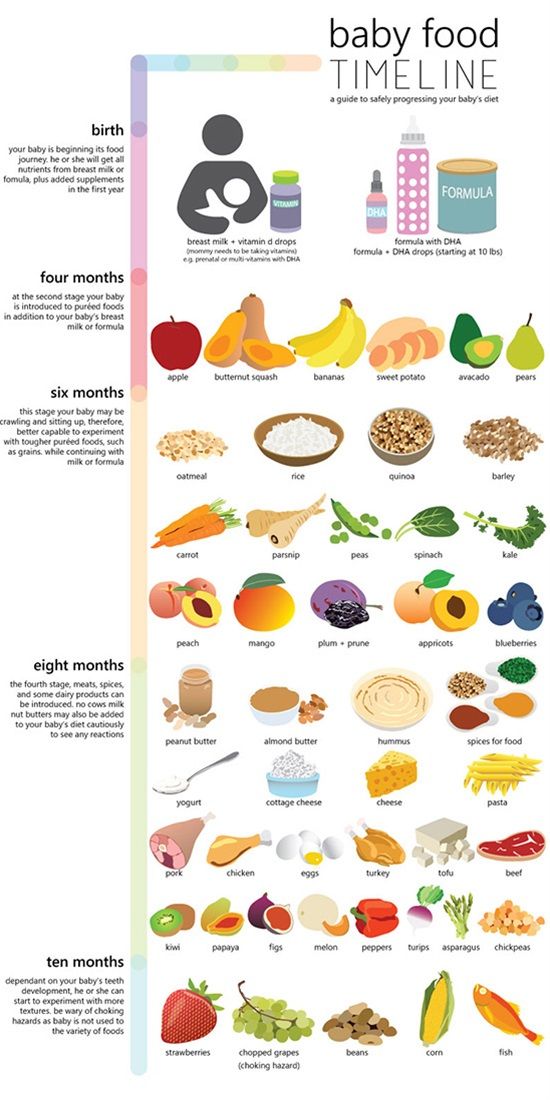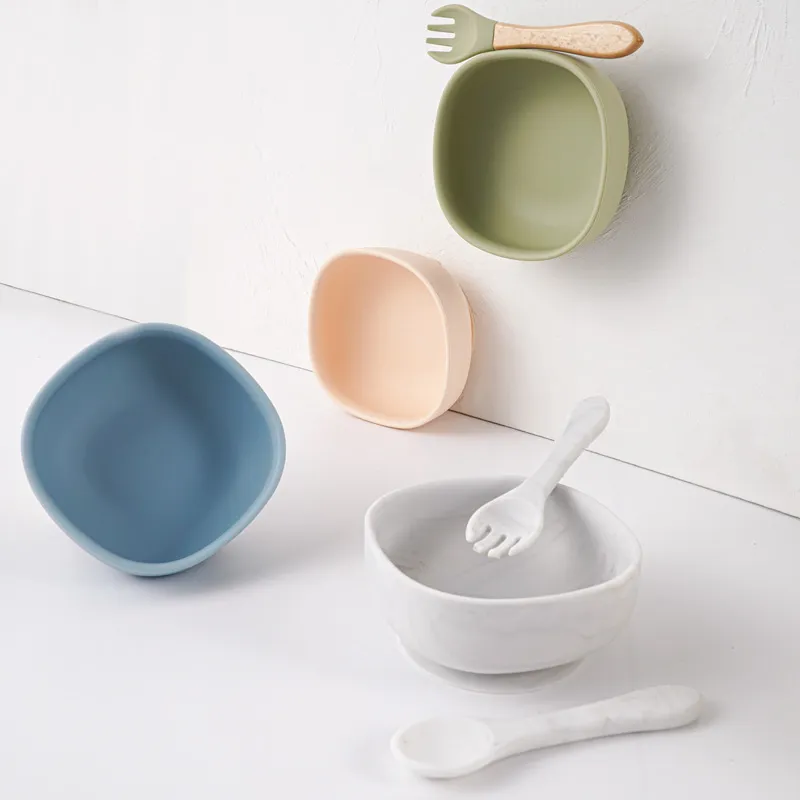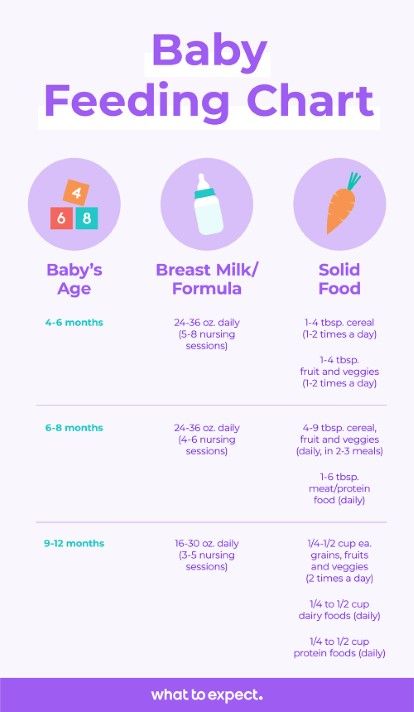What to feed baby oscar fish
What Do Oscar Fish Eat? (A Complete Guide)
What do Oscar Fish eat? This is the question many beginners ask when they want to keep Oscar Fish in their tank.
And in this article, I am going to tell you everything you need to know about Oscar Fish food, feeding Oscar Fish and much more.
So let’s get started.
Oscar Fish eat live, frozen or dried food like Bloodworms, Brine shrimp, etc.
It can also eat vegetables such as boiled Peas, blanched Spinach, Lettuce, etc.
You can also feed it flakes and pellets.
Table of Contents
Best food for Oscar FishOscar Fish are omnivorous and in the wild, they mostly feed on Crustaceans, Insects and plant matter.
You should try to match this diet when to feed Oscar in your aquarium.
Providing a balanced diet is very important for healthy Oscar Fish.
If your Oscar Fish doesn’t get a properly balanced diet then it can lead to diseases.
Oscar Fish’s diet mostly consists of meaty foods.
But as they are omnivorous, so you should occasionally feed them plant-based food like different types of vegetables like Spinach, Cucumber, Lettuce, etc.
Flakes and pelletsIn your aquarium, you should mostly feed high-quality cichlids flakes and pellets to your Oscar Fish.
High-quality cichlids flakes and pellets contain all the essential nutrients that a fish require for their proper development.
The flakes and pellets should constitute about 70 to 80% of their weekly diet.
You should keep in mind a couple of things while choosing flakes and pellets for your Oscar Fish.
- The flakes and pellets should be of high quality and contain a good amount of protein. You should go for cichlids flakes and palate as it contains a high amount of protein.
- Flakes and pellets come in different sizes so you should choose it according to the size of your Oscar Fish.
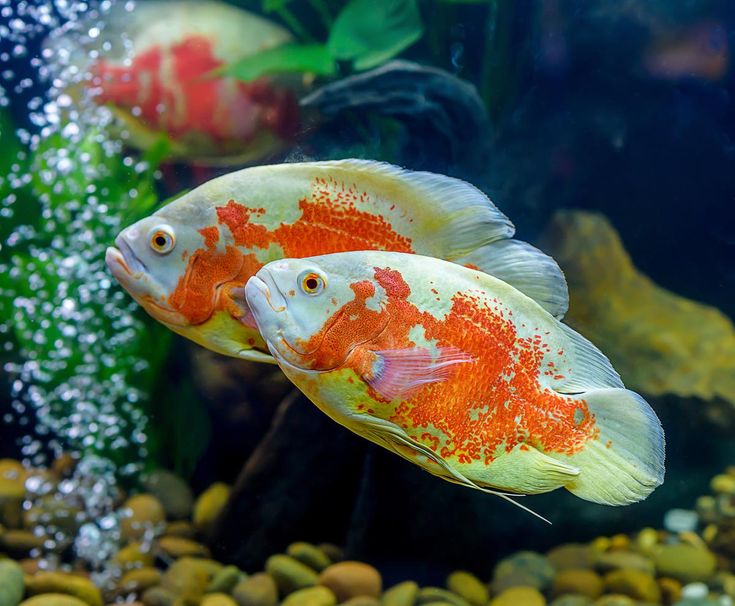
Usually, it comes in three sizes
- Small
- Medium
- Large
So if you have baby Oscar Fish below 4 inches long then you should go for small pellets. If your Oscar Fish is about 5 to 10 inches then you should go for medium size pellets.
And if your Oscar Fish is more than 10 inches then you should go for large pellets.
Basically, the size of the pellets should not be too large to fit into the mouth of your Oscar Fish.
Because then it will be difficult for your Oscar Fish to swallow it and that can lead to complications.
While choosing this size of the pellets, you have to be careful especially if you have baby Oscar Fish.
Baby Oscar fish are voracious eaters.
They try to eat whatever you put in the tank no matter if they can swallow it or not.
So, as mentioned earlier, for baby Oscar Fish you should choose small size pellets.
Are Oscar Fish Good Pets?
Live food
Watch this video on YouTube
In the wild, Oscar fish feeds on live food such as Crustaceans, small fish, and insects.
There is a lot of variety of live food you can feed to your Oscar fish in your aquarium.
Below is the list of the live food you can feed to your Oscar Fish.
- Blood worms
- Earthworms
- Mealworms
- Black worms
- Waxworms
- Shrimp
- Crickets
- Grasshoppers
You can also feed feeder fish to your Oscar fish.
Some popular types of feeder fish are Guppies, Rosy red minnows, and Goldfish.
But you should avoid feeding Goldfish to your Oscar Fish.
The problem with Goldfish is that Goldfish are more susceptible to diseases and they are at high risk of transferring harmful bacteria, viruses in your tank.
Besides, there are a few things that you should keep in mind while feeding live food to your Oscar Fish
- Live food is the most nutritious food you can feed to your Oscar Fish. But it also carries a risk of transferring harmful bacteria or viruses in your tank.
 So you should only get live food from a reputed shop.
So you should only get live food from a reputed shop.
- If you don’t find any reputed shop then you can breed feeder fish on your own. If you are planning to breed feeder fish on your own then Guppies are a very good choice because they are prolific breeders and they breed very often.
- As mentioned earlier, you should avoid feeding Goldfish to your Oscar Fish because they are very susceptible to diseases and they can easily transfer harmful bacteria and viruses in your tank and make your Oscar Fish ill.
- Live food has a very short shelf life so you should feed the live food within 2 to 3 days after getting it.
- You should not feed live food very frequently to your Oscar fish. If you do so, you may spoil your pet and now your Oscar fish just want to eat live food and nothing else.
So you should feed live food occasionally maximum 3 to 4 times per week.
Frozen or dried food
Frozen or dried food may not be as nutritious as live food but they are still very nutritious.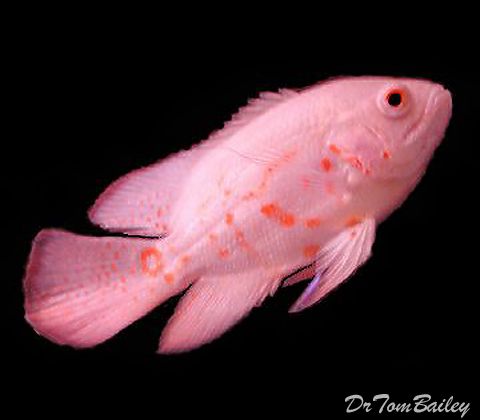
And most importantly they don’t carry any risk of transferring harmful bacteria and viruses in your tank.
Besides, frozen or dried food is very convenient to feed to your Oscar Fish and they have a longer shelf life.
You can feed a lot of different types of frozen and dried food to your Oscar fish like frozen or dried Bloodworms, brine shrimp, etc.
Plant-based foods
Oscar Fish are omnivorous so you should also occasionally feed them plant-based food.
The most convenient food you can feed to your Oscar fish is vegetables.
You can feed them various different kinds of vegetables and fruits.
While feeding the vegetables just make sure to boil or blanched it and cut it down into small pieces if you have baby Oscar Fish.
The list of the vegetables you can feed to your Oscar Fish is as follows
- Green peas
- Carrot
- Spinach
- Lettuce
- Cucumber
The list of fruits you can feed to your Oscar fish is as follows
- Apple
- Banana
While feed fruits, make sure to cut it down into small pieces and remove the seeds from it.
Oscar Fish Tank Size (A Complete Guide)
What human food can Oscar Fish eat? Oscar Fish can eat a variety of human food.
Seafood
You can feed Oscars various types of seafood.
You can feed them small pieces of tuna and Salman.
They also enjoy eating mussels and cockles.
You can also feed them prawns and shrimp. It will provide them a lot of fiber which is good for their digestive system.
Vegetables and fruits
As mentioned earlier, you can feed a variety of vegetables and fruits to your Oscar Fish.
Some good examples include Spinach, Lettuce, Green peas, Carrots, Apples, Banana, etc.
Animal meat
Occasionally, you can also feed different types of animal meat such as Beef, Chicken and other types of animal meat to your Oscar fish.
You should not feed the animal meat to your Oscar fish frequently.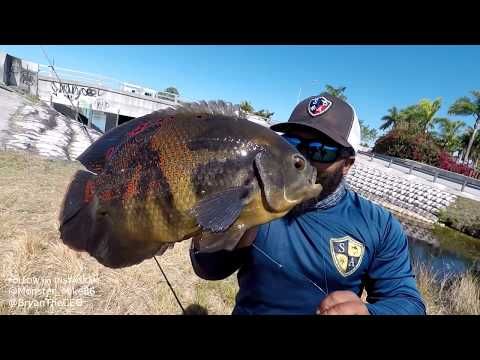
Animal meat contains a lot of saturated fats and fish liver is not very good at processing saturated fats.
If you overfeed animal meat to Oscar fish then most likely it is going to cause fatty liver disease in the fish.
So either you can completely avoid feeding animal meat to your Oscar Fish.
Or you can feed animal meat very occasionally and it will not be a problem.
Beef heart is one of the best animal meat you can feed to your Oscar fish because it does not contain a lot of saturated fats.
13 Types of Oscar Fish For Aquarium (With Images)
How often to feed your Oscar Fish?To an adult Oscar fish, you should feed once or twice a day.
To a juvenile Oscar fish, you should feed 2 to 3 times for a day.
If you have baby Oscar Fish i.e. the size of the fish is less than 4 inches then they require more food for their fast growth.
So ideally, you should feed them 3 times a day.
To the Oscar fish which is more than 4 inches and under 10 inches, you should feed it twice a day.
And to the Oscar fish which is more than 10 inches long, you can feed it once a day.
12 Best Tank Mates For Oscars (With Images)
How much to feed to your Oscar Fish?A good rule of thumb to follow is to feed the amount of food for Oscar Fish can eat within 2 to 3 minutes.
Overfeeding Oscar Fish can be risky. It can cause digestive problems in the fish.
So you should avoid overfeeding your Oscar fish at any cost.
Live foodIf you are feeding feeder fish to your Oscar Fish then you should feed a maximum of 2-3 fish at a time.
And you should not feed more than a few fish a week to your Oscar Fish.
There are actually a few drawbacks of feeding a lot of live food to your Oscar Fish
- First of all, if you feed a lot of live food to your Oscar Fish then you may be spoiling your fish and your fish may reject to eat any other type of fish food.

- Live food is a very nutritious food but they don’t provide all the nutrients that a fish require for their proper growth.
- Feeding a lot of feeder fish to your Oscar fish can also lead to obesity because fish contain a lot of fat.
- Also, when you introduce a lot of feeder fish in your tank, it can also cause a sudden spike in the ammonia levels which is harmful to Oscar Fish.
- And if you observe sudden spikes in the ammonia levels very frequently then you will also have to do water changes very frequently.
- Live food doesn’t have a long shelf life so it is very inconvenient for you to go to the pet store frequently to get live food.
- Besides, live food also carries the risk of transferring harmful bacteria and viruses in your tank.
When it comes to feeding flakes and pellets to your Oscar fish, first of all, you should choose the size of the flakes and pellets according to the size of the mouth of your Oscar fish.
Pallets come in three sizes (small, medium, and large).
If you have baby Oscar fish i.e. the size of the Oscar fish is less than 4 inches then you should go for small size pellets.
If the size of your Oscar fish is anywhere between 5 to 10 inches then you should go for medium size pellets.
And if the size of your Oscar fish is more than 10 inches then you can go for large flakes and pellets.
You have to be very careful while choosing the size of the pellets especially if you have baby Oscar fish.
Because baby Oscar fish are voracious eaters and they will try to eat anything you put in their tank no matter they can swallow it or not.
So if you put large pellets in the tank then they will not be able to swallow it and it can cause complications.
While feeding flakes and pellets, you should put 2-3 flakes or pellets in the tank and then let the fish finish it.
And then you should put a few more flakes and pellets and let the fish finish it.
You should do this process for a maximum of 3 minutes.
Oscar fish are omnivorous so once in a while you should also feed vegetables to your Oscar fish.
Though Oscar fish are omnivorous, their diet mostly consists of meaty food so they don’t require a lot of plant-based food.
Feeding Oscar fish vegetables once ina week is sufficient.
Besides, if you have some live plants in your tank then Oscar fish may nibble on them occasionally and you don’t even need to feed vegetables to your Oscar fish.
52 Best Freshwater Aquarium Plants For Beginners (And Care Guide)
Best Oscar Fish food for colorThere are a few foods that can help enhance the color of your Oscar fish.
So if you want to enhance the color of your Oscar fish then you should look for the food that contains Astaxanthin.
River shrimp and skrill contain Astaxanthin.
Green peas can also help to enhance the color of your Oscar fish.
Are Oscar Fish Aggressive?
How to make fish food for your Oscars at home?Making fish food for Oscar Fish is a pretty simple task but it will take some time.
Also, if you make fish food in a bulk then it will be a bit cheaper.
To make fish food for Oscars, first of all, you will have to choose ingredients.
Oscar Fish are omnivorous but their diet mostly consists of meaty foods.
So to make fish food for your Oscar Fish you should choose only meaty food.
And to fulfill their vegetarian diet you can feed them vegetables separately.
You can choose ingredients such as Shrimp, Bloodworms, Whitefish meat, etc.
Then you will have to cut it down into small pieces.
You should cut it down according to the size of the mouth of your Oscar Fish so that it can easily fit into the mouth of your Oscar fish.
Then put all the ingredients in a bowl and mix them well.
At this point, you can also add liquid vitamin boosters to provide essential vitamins to your Oscars.
Many brands make liquid vitamin boosters and you can easily find them at your local pet store.
After mixing everything well just let it soak for about an hour.
After an hour, now it’s time for the packaging.
For the packaging, just take a little amount of the mixture and put it in in freezer bag.
Then close the bag and press the bag with your hands and make it flat.
Once that done, just put the bags into the freezer for about 24 hours and now your fish food is ready.
While feeding it to your Oscars you can directly take a piece out of the bag and put it in the tank. Or you can soak it in the water from your tank and then feed it to your Oscar Fish.
How you should feed really comes down to the feeding habits of your Oscar fish.
Now one thing you should be careful about feeding the homemade food to your Oscar fish is that you should not feed only the homemade food for Oscar fish.
Because if you do so then the fish will get used to the homemade fish food and if you want to feed it other food such as Flakes and Pellets then it will not eat it.
So you should keep feeding other foods as well along with your homemade food.
12 Benefits of Live Plants in an Aquarium
What to do if Oscar Fish is not eating food?There could be several reasons your Oscar fish is not eating food or spitting it out.
Before doing anything else, first, you should check the water quality of your tank.
You should check for Ammonia levels, Oxygen levels, Temperature, pH and hardness of your water.
The ideal water parameters for Oscar fish are as follows:
- Temperature- 74 to 81° Fahrenheit
- pH- 6-8
- Hardness- 5 -20 KH
So you should make sure the water parameters of your tank are within the ideal range.
Talking about Ammonia levels, ideally, your tank should not contain any Ammonia.
If you noticed high ammonia levels in your tank then you can use these ways to reduce the ammonia levels and get rid of it.
There are a few signs that suggest low oxygen levels in your tank.
- If you notice rapid gills moment of your Oscar fish then it is a sign of low oxygen levels.
- If you notice your fish is coming to the surface of the tank gasping for air very frequently then it is a sign that your tank has low oxygen.
- If you notice that your fish is not moving as much and as quickly as it used to then this could be the sign that your fish tank doesn’t have optimum oxygen levels.
So if you notice any of the above signs then you can introduce some oxygenating plants in the tank or use these ways to increase oxygen in your tank.
15 Ways to Lower Temperature in an Aquarium
Change the foodOscar fish prefers a varied diet. So if you are feeding only one type of food to your Oscar fish then this could be the reason your Oscar fish is not eating the food.
In this case, you should try to feed other types of food for Oscar fish.
Also, when you get Oscar fish for the first time and introduce it into your tank or if you have moved your Oscar Fish to a new tank.
Oscar Fish usually gets very fussy and refuses to eat the food.
It is their normal behavior and after some time they will start eating the food.
Oscar fish are very picky when it comes to dry food.
So you should get at least two to three types of dry food and feed them one by one.
Then most likely you will know what type of dry food your Oscar fish prefers and then you should continue feeding it.
Oscar fish is going to eat other types of remaining dry food over time.
When Oscar fish is sick or ill, it tends to refuse to eat.
So you should see if your Oscar fish is showing any signs of any disease and do medications accordingly.
Get him a female OscarIt normal for a male Oscar Fish not to eat during the breeding period.
You will also notice that your male Oscar fish has lost some weight during this period.
So to cope with this problem, you can get a female Oscar fish for him and hopefully he will start eating again.
15 Things You Must Know Before Buying Your First Aquarium
FAQWhat do baby Oscar Fish eat?Baby Oscar fish can eat flakes and pellets.
You can also feed it live food such as Bloodworms.
As Oscar Fish is omnivorous, you should also feed it vegetables occasionally.
While feeding food to the baby Oscar fish you should make sure that it is not too large to feet into the mouth of the baby Oscar Fish.
Baby Oscar fish are voracious eaters and they will try to eat anything you put into their tank no matter if they can swallow it or not.
Flakes and pellets come in three sizes- small, medium and large.
So you should choose small size pellets for feeding your baby Oscars.
Also, while feeding the vegetables you should cut it down into small pieces so that baby Oscar fish can swallow it easily.
You can feed it vegetables like boiled peas, blanched spinach, lettuce, small pieces of carrots, etc.
6 Tips to Take Care of Live Plants in Aquarium
What vegetables does Oscar fish eat?You can feed a lot of different types of vegetables to your Oscar Fish such as Zucchini, Spinach, Cucumber, Green peas, Lettuce, etc.
While feeding the vegetables, you should boil or blanched it and cut it down into small pieces according to the size of your Oscar fish.
Can Oscar Fish eat flakes?Yes, you can feed flakes to your Oscar fish.
While choosing flakes for your Oscar Fish, just make sure that it is high quality i.e. it contains a good amount of protein.
There are flakes that are specially made for cichlids that contain a high amount of protein so you should choose Cichlids flakes for your Oscar fish.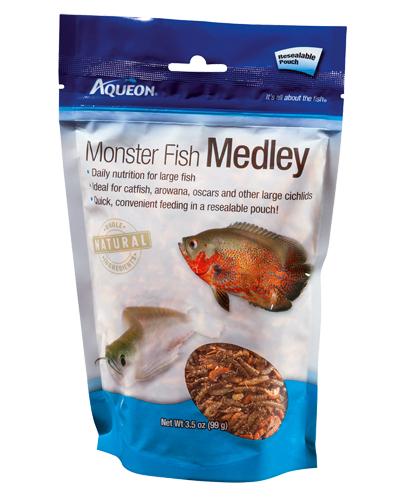
Flakes usually come in three different sizes so you should choose them according to the size of your Oscar fish.
For example, if you have juvenile Oscar Fish i.e. if the size of your Oscar Fish is less than 4 inches then you should go for small size flakes.
For the Oscar Fish between 5 inches 10 inches, you should go for medium size flakes.
And if you have Oscar Fish larger than 10 inches then you should go for large size flakes.
Can Oscars eat bananas?Yes, you can feed bananas to your Oscar Fish.
While feeding banana, just make sure to cut it down into small pieces so that it will be easier for your Oscar fish to consume it.
Yes, you can feed earthworms to your Oscar fish.
Earthworms are very nutritious and they contain a good amount of protein so they are good for your Oscar fish.
Besides earthworms, you can also feed other types of worms such as Bloodworms, Mealworms, Waxworms, etc.
Yes, you can feed Chicken to your Oscar Fish. But you should not feed Chicken very frequently.
The thing is, all animal meat like Chicken contains saturated fats and fish are not very good at processing these fats.
If you feed animal foods to your Oscar fish very often then it raises the risk of causing fatty liver disease in the Oscar fish.
Feeding chicken once in a while is not a problem.
How long can Oscars can go without food?Oscar can go anywhere between 3 days to up to 3 weeks without food.
It really depends on the size of your Oscar Fish.
If you have a baby Oscar fish then it will not last for more than a week and even less without food.
But if you have a large Oscar fish of 15 inches then it can survive for up to 3 weeks without food.
If you are going away from your home and concerned about feeding your Oscar fish then there are a few ways you can cope with this problem.
Ask your neighbor or friend
The most simple and reliable way to feed your Oscar fish when you are away is to ask your friend or neighbor to feed your Oscar fish.
You should also tell them how much quantity they should feed to the fish because it is very easy to overfeed a fish.
A simple way to cope with this problem is to get a pill organizer and put the amount of food you usually feed to your Oscar fish every mealtime.
And then tell your friend or neighbor to empty one box every time.
Use an automatic fish feeder
Using an automatic fish feeder is another way to keep your Oscar fish well-fed when you are away.
You just have to put the food in the automatic fish feeder, set the time intervals and it will automatically start dispensing the food according to the time you set.
Check out our recommended Automatic Fish Feeder
Use slow-release fish food
Using slow-releasing fish food is the cheapest option to keep your fish well-fed when you are away.
The slow-releasing fish food comes in two types
- Weekend feeder blocks
- Vacation feeder blocks
Weekend feeder blocks
As the name suggests, the weekend feeder blocks will last for three days i.e. it will slowly release the food that will last for 2 to 3 days.
Vacation feeder blocks
If you are planning a long vacation then you can use vacation feeder blocks.
You just have to toss it into your tank and it will slowly break down the food over a period of 2 weeks.
Below is the table that shows different types of slow-releasing fish food and their validity.
| BRAND | LASTS FOR | SUITABLE FOR |
|---|---|---|
| TetraPond | 14 Days | Pond fish |
| Tetra Weekend | 14 Days | Tropical fish |
| Zoo Med | 14 Days | Bottom feeder |
| Zoo Med Mini | 7 Days | Gourami and small fry |
| Zoo Med Betta | 7 Days | Betta |
| Pyramid Automatic feeder | 3 Days | All types of fish |
20 Tips to Maintain a Healthy Aquarium
ConclusionSo, as you can see, Oscar fish can eat a variety of food.
You should provide a balanced diet to your Oscar fish and try to feed it a variety of food.
While choosing the food, just make sure that it is of high quality.
I hope you found this article helpful.
If you do, please share it.
Happy fishkeeping!
Feeding Oscar Fish | Tropical Fish Hobbyist Magazine
Author: Brian M. Scott
Oscars Astronotus spp. are some of the most popular and commonly kept fish in the aquarium hobby. In this installment of “Top of the Food Chain” I will rediscover my roots, so to speak, and pass along some useful information that I have gathered on successfully maintaining oscars in home aquaria.
Introduction
Most hobbyists have at least heard of oscars at some point in their fishkeeping careers, and many have kept them in home aquariums. After all, who can resist those big bug eyes and that incredible dog-like personality? Well, not many, and rightfully so. Oscars are amazing fish and exhibit some of the most unique and fascinating behavioral and husbandry traits of any commonly available freshwater aquarium species. This month I’d like to focus on passing along snippets of information that I have gathered on the proper diet and feeding of oscars in aquariums. So let’s jump right in!
This month I’d like to focus on passing along snippets of information that I have gathered on the proper diet and feeding of oscars in aquariums. So let’s jump right in!
Diet in Nature
Oscars are native to tropical and subtropical South America. Throughout their range wild oscars primarily consume meaty foods (mostly small whole fishes), while much of the remainder of their diet consists of live insects and insect larvae. It’s hard to break down the actual percentages of food types consumed, but it’s probably safe to say that live fishes and insects constitute approximately 90 percent of the overall diet of wild oscars.
Even though live fishes and insects make up the bulk of a wild oscar’s diet, there are other items that are taken as well. Fruits, nuts, shrimps, and snails are noted fare, with the fruits and nuts being consumed somewhat on a seasonal basis. Additionally, some authors have reported oscars being sighted around dead animals lying in the water. It is uncertain, however, if these fish were feasting on the actual dead animal or on the small fishes that such carrion attracts.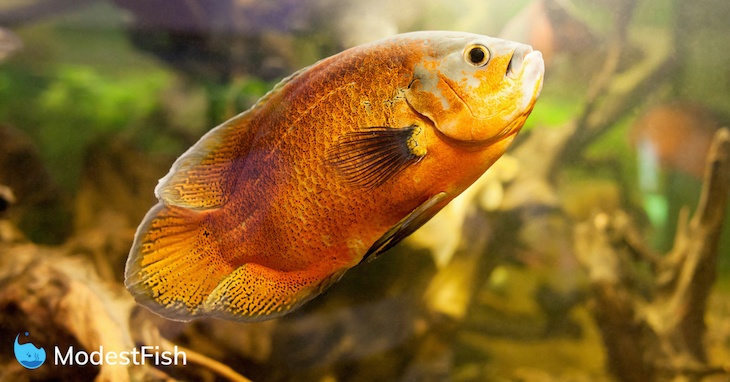 I would say the latter theory is more widely accepted.
I would say the latter theory is more widely accepted.
Diet in Aquaria
The diet of oscars maintained in aquariums is often drastically different compared to that of their wild counterparts. What I mean by this is that it’s rather uncommon for hobbyists maintaining oscars to feed them a variety of foods so as to replicate food selection in nature. Generally the two major foods being offered to aquarium-housed oscars are live feeder fishes and pellets formulated for large aquarium fishes.
It’s been my experience that oscars do best when offered a variety of foods, and while a diet that reflects that of a “natural” one is somewhat difficult for many hobbyists, it is extremely rewarding and surprisingly affordable to offer a diet that is at least close to that of a wild oscar.
Live Fishes
Many folks offer their oscars a diet made up almost exclusively of live feeder fishes. While live feeder fishes certainly do have their place on the menu for predatory fishes, they should never be the sole food offered unless such a diet is part of a larger goal (i. e., breeding, etc).
e., breeding, etc).
One of the biggest issues regarding the feeding of live fishes to any fish, oscars included, is the potential for disease transmission. Since many feeder fishes, especially goldfish, are raised in huge numbers by fish farmers, the risk of disease transmission is high. However, such a problem is less likely to occur these days compared to years past. The increased understanding of raising, transporting, and maintaining feeder fishes like goldfish and rosy red minnows has made them safer to use today than ever before. That said, I still do not advocate the use of live feeder fishes as an exclusive diet.
Insects & Worms
During the rainy season, when fish are scattered throughout the flooded forest, oscars tend to shift their diet toward insects and insect larvae. I have found insects like small crickets and mealworms to be fantastic foods for oscars. Be careful not to use insects that have been exposed to chemicals like fertilizers or insecticides.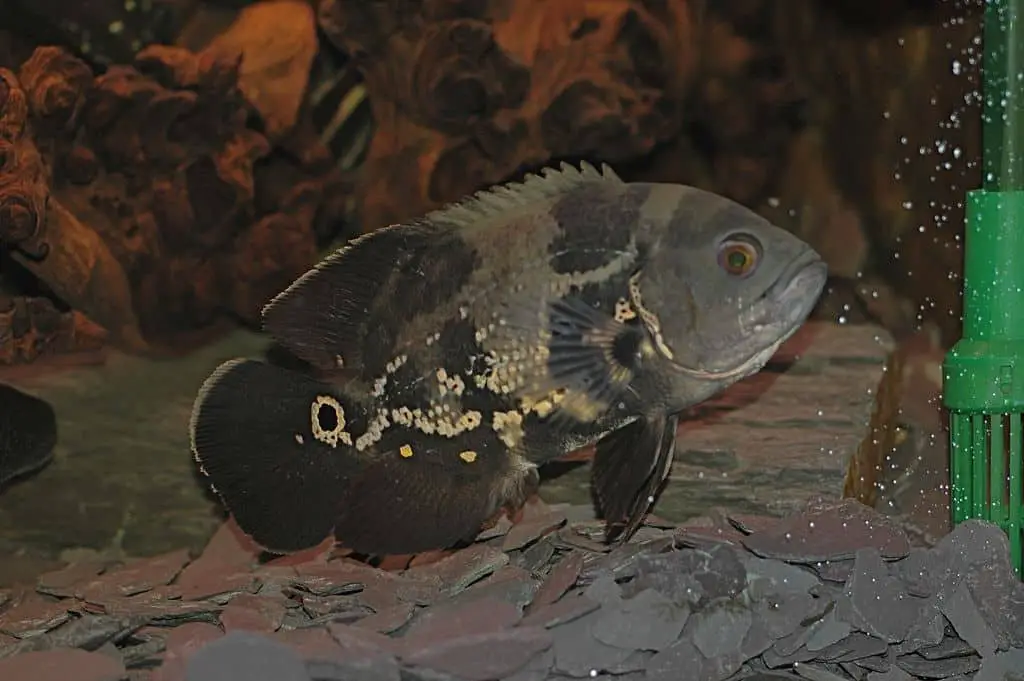 If you are uncertain of whether or not the crickets in your backyard have been poisoned, then simply do not use them. Your local pet shop will most likely be able to provide you with farm-raised crickets, mealworms, wax worms, and a wide array of other safe insects that are suitable as oscar food.
If you are uncertain of whether or not the crickets in your backyard have been poisoned, then simply do not use them. Your local pet shop will most likely be able to provide you with farm-raised crickets, mealworms, wax worms, and a wide array of other safe insects that are suitable as oscar food.
Fairly recently—at least within the past decade or so—several companies have began offering crickets and other insects in a prepared form, which are usually sold in small cans. These are perfect for use as oscar food, and many other species of fishes will benefit from their use as a dietary supplement as well.
Fruits, Nuts, and Veggies
Another food that oscars exploit during times of high water are the fruits (nuts) of several tropical trees. I have seen more than one oscar feed on peanuts or other somewhat soft nuts. Tropical nuts may not be available, and that’s fine. I would recommend feeding just one or two shelled nuts at a time. If the fish eats them, great, if not perhaps try again when you think he’s a bit hungrier—like in about five minutes!
I could probably write an entire article on just fruits and such for the oscar diet, but I wouldn’t want to get any nasty e-mails from my readers for wasting their time. However, let me just make mention of one particular type of veggie that I feel warrants special attention—frozen peas.
However, let me just make mention of one particular type of veggie that I feel warrants special attention—frozen peas.
Frozen peas are a secret weapon in my arsenal of oscar foods. Without getting too deep into the science behind why I use these, let me tell you that they just simply work at enhancing the color and vigor of oscars in general. I always feed them frozen, too, which is not the norm when it comes to feeding my fishes frozen foods.
It’s very simple really; I just go to the supermarket and buy a small bag of frozen peas. Always keep them frozen, even until right before you offer them to your oscars. When the time comes for feeding, simply remove a few and rinse them under cold water then throw one at a time into the tank. If you have never offered your oscar this treat before, he may spit them out. Eventually, though, he will take them—and love them!
Prepared Foods
Prepared foods like pellets, tablets, crisps, flakes, and wafers are by far the most popular and easily found foods for feeding all aquarium fishes. Be smart, however, in the way you feed these foods to an oscar. Oscars are generally messy eaters, and the small particles that are produced by the fish’s chewing action are notorious for causing major water-fouling issues.
Be smart, however, in the way you feed these foods to an oscar. Oscars are generally messy eaters, and the small particles that are produced by the fish’s chewing action are notorious for causing major water-fouling issues.
I have found that tablets, wafers, and pellets are more effective than crisps or flakes, even when an oscar is a juvenile. They tend to swallow tablets and pellets whole, with less gumming up, and wafers can easily be split in thirds and then offered to the oscar. When possible, try and offer prepared foods that are high in plant matter, as oscars tend to lack such materials in their diet. If these materials aren’t provided, then the fish’s colors can become faded and less striking over time, especially as it matures and grows into its adult coloration.
Try to offer a variety of prepared foods. It’s a good idea to have a half-dozen different kinds ready to supplement the oscar’s diet at any given time. This will make it very easy to vary their diet on a daily basis—even if it’s simply just varied in the type of pellets that are offered.
Fresh & Frozen Foods
Other foods that warrant mention for inclusion in the overall oscar diet are those foods that we call fresh and/or frozen. In most cases, when someone refers to such foods they are speaking of some form of seafood. Nearly all seafood is good for an oscar, as long as it’s offered in moderation, which is true for all types of foods, by the way—again, maintaining a varied diet is a key to success.
Fresh or frozen seafood like shrimps, scallops, clams, and squid make excellent additions to the fish’s diet and should be used often and in alternating form. One day shrimp, a few days later squid, and so on. Be creative but never overdo the seafood.
Other types of frozen foods like brine shrimp, bloodworms, mysis shrimp, and various similar formulas are not suitable for any but the smallest of oscars. Oscars are simply just too messy when it comes to feeding, and the small particles in such foods will do more harm than good for the fish in the long run. Stick to the big stuff, and simply cut it down to size as needed.
Stick to the big stuff, and simply cut it down to size as needed.
Quick Tips for Feeding Oscars
Oscars are gluttons, and they will consume as much food as they can possibly stuff in their bodies. Of course, and it should go without saying, that includes tankmates too. Since this article is primarily about the oscar’s diet and feeding, I won’t go into some of the other major husbandry factors that all hobbyists keeping these fish should be aware of, but I encourage you to take the reins and research everything possible on the subject.
Oscars are basically ravenous feeders, so feeding them should be a breeze—and it is! But be warned, just because your oscar ferociously consumes all that’s edible does not mean that you are feeding him properly. The key is moderation.
Oscars are always in competition mode. They compete against each other and anything else that eats, including their tankmates. Special attention should be paid as to how much and how often your oscar should be fed. Since we already discussed what to feed your oscar, let’s now move on to how to feed these fish.
Since we already discussed what to feed your oscar, let’s now move on to how to feed these fish.
Juveniles
Small oscars that measure between 1½ and 3 inches should be fed at least twice daily. Now let me interject a point right here: these guidelines are estimates, and you will need to experiment a little to see what works best for your situation.
Generally, small fish need to feed at least twice daily, and juvenile oscars are no exception. I tend to only feed baby oscars until their bellies are slightly distended; that is called feeding satiation. Try and vary the foods a bit, even on a daily basis. For example, mysis shrimp in the morning and a staple pellet in the afternoon or early evening. Also make sure that you are offering a small amount of food at a time. Let the fish actually swallow some before you dump more in their tank. If you add too much, oscars tend to gum and spit their food in an effort to move on to the next piece that is offered. Basically it should take longer than 10 seconds to feed your fish. You enjoy watching your oscar, so take your time!
You enjoy watching your oscar, so take your time!
Subadults
Most species grow very fast as juveniles, but few continue to grow as fast when they get to the sub-adult stages. Oscars are one of the few. Feeding oscars in this growth stage is very easy. By the time they hit 4 inches long they are well established. When they grow to between 4 and 6 inches continue to feed them daily, but perhaps alternate their feeding schedule; one day feed them twice and the next day just once. This will allow them to get daily nutrition, but it is curtailed just a bit. Remember, keep their diet varied for best color and vigor.
Adults
At about 7 or 8 inches we consider oscars adults. I have seen 5-inch specimens actually lay eggs and produce viable offspring, but I feel they (the adults) were stunted. At this time you should be feeding a very wide assortment of foods. Now is the time to really watch the weight of the oscar. If you feel that he is a bit too chunky, then play around with your feeding regimen. I have seen many hobbyists feed adult oscars only twice weekly; however, I feel that because of the gluttonous behavior of adults and the punishment that such beasts will unleash on their tankmates, the best regimen is to feed them every-other day, and twice weekly feed the adult two or even three times in a given day.
I have seen many hobbyists feed adult oscars only twice weekly; however, I feel that because of the gluttonous behavior of adults and the punishment that such beasts will unleash on their tankmates, the best regimen is to feed them every-other day, and twice weekly feed the adult two or even three times in a given day.
It is common for large adults, say over 12 inches, to feed on a very narrow scope of foods. This is most likely because they have never been offered them previously. If you raise a small oscar on a widely varied diet, then you will eventually have a very large oscar that will continue to feed on, quite literally, anything edible. And that’s the way it should be!
Amazing Pets
Oscars are true aquatic pets. They can recognize their owners and are accomplished beggars when it comes to feeding time. Offer them a varied diet and be careful to not overfeed, as they don’t usually need as much food as their dog-like behavior may lead you to believe. If you provide them with a large well-filtered aquarium, good quality food in moderate amounts, and lots of attention, then there’s a good chance your oscar will give you many years of fun and enjoyment.
What food do aquarium fish eat, how to feed aquarium fish
How to choose food for fish, not to get lost in a huge variety of species and brands, to choose a good composition that will serve as a disease prevention and give a long life to the inhabitants of the aquarium? Our review will help answer this question: you will find out which products are recognized as the best and are most in demand among experienced aquarists.
Feed varieties
Food for fish should be selected depending on their size, structural features of the oral apparatus. As you know, both predators and herbivores can live in aquariums, which will eat differently. It is customary to single out:
- Feed in the form of tablets - intended for feeding bottom dwellers with a lower mouth, as well as for snails and shrimps.
- In the form of flakes, chips - it will be appreciated by the fish in the aquarium, accustomed to swimming in its middle part, for example, cockerel fish.
 Experts recommend adding ornathus chips or flakes to gourami, including feeding guppy fish, despite the fact that it is considered an omnivore.
Experts recommend adding ornathus chips or flakes to gourami, including feeding guppy fish, despite the fact that it is considered an omnivore.
In our online store you can buy granular fish food from leading manufacturers:
250 ml
626 ₽
573 ₽
250 ml x 2 pcs
1 252 ₽
1 089 ₽
250 ml x 6 pcs
show all sentences
9000 35 g 9000 72 ₽ ₽ ₽66 ₽
35 g x 2 pcs
144 ₽
128 ₽
35 g x 10 pcs
720 ₽
619 ₽
Show all sentences
100 ml
473 ₽
433 ₽
100 ml x 2 pcs
946 ₽
823 ₽
9000 ml x 6 pcs 9000 9000 Show all sentences to show all sentences to show all sentences100 ml
182 ₽
166 ₽
100 ml x 2 pcs 2 pcs
100 ml x 12 pcs
show all sentences
1 l
495 ₽
453 ₽
9000 1 l x 2 pcs990 ₽
862 ₽
1 l x 4 pcs
show all sentences
500 ml
1 117 ₽
1 023 ₽
500 ml x 2 pcs
2 234 ₽
1 945 ₽
500 ml x 4 pcs
Show all offers
- In the form of granules, sticks.
 When in contact with water, the food increases in size, suitable for feeding large representatives of the aquatic world. It is important to organize the correct dosed feeding of aquarium fish, not allowing them to eat outside the schedule.
When in contact with water, the food increases in size, suitable for feeding large representatives of the aquatic world. It is important to organize the correct dosed feeding of aquarium fish, not allowing them to eat outside the schedule. - Microfood - they are fed to fry and small fish (including newborn bettas, guppy fry) that are unable to grasp a large piece. It requires timely cleaning of the environment, as it settles at the bottom, polluting the water.
Separately, it must be said about live food, it can be coretra, daphnia, cyclops, bloodworm, tubifex, large predators eat squid or shrimp with pleasure.
What kind of food do aquarium fish eat
Choosing dry food for guppies, motley cockerels and other species should be based on a combination of the most important characteristics - composition, shape, price. Modern brands use dried insects, vitamin supplements, healthy algae as raw materials. In cheap feeds, the protein component is negligible, most of the composition is represented by useless chitin, which inevitably leads to frequent morbidity and shortens the life expectancy of pets if fed on an ongoing basis.
The shape and size of the food should correspond to the size of the fish. Manufacturers indicate on the packaging for which varieties this or that food is intended. The price of feed usually corresponds to its quality, well-known brands value their name and reputation, produce a quality product, the price of which is slightly higher than the average.
Feed storage
Food has an expiration date. An open jar can be stored for no more than 2-5 months, in order to avoid damage, try to buy the amount that you will use up in the near future. Otherwise, the added vitamin complex will collapse and the fish will not get good nutrition.
Live food should be stored in the refrigerator using a damp cloth. The term of keeping the larvae is limited by their lifespan, which is usually no more than 2-3 days. When using jelly-like food, care must be taken to ensure that the production date is fresh to ensure maximum nutrient content.
How to feed
The main rule is not to overfeed or exceed the recommended feeding frequency. Most of the inhabitants of the aquarium (swordtails, cockerels, barbs, guppies) are not able to control the feeling of satiety, they will consume everything that you pour. This will certainly lead to obesity, and subsequently, to the death of guppies and other pets. Follow the recommendations:
Most of the inhabitants of the aquarium (swordtails, cockerels, barbs, guppies) are not able to control the feeling of satiety, they will consume everything that you pour. This will certainly lead to obesity, and subsequently, to the death of guppies and other pets. Follow the recommendations:
- Adult bettas and other fish should eat 1-2 times a day;
- you need to feed so that the fish eats the pellets in 2 minutes;
- do not allow components to sink to the bottom, except for special tablets.
Feed manufacturers indicate on the product packaging how much to feed at a time and how often to replenish fish stocks.
Our range includes universal feeds, diets for goldfish and other ornamental species:
20 g
134 ₽
124 ₽
20 g x 2 pcs
268 ₽
240 ₽
20 g x 10 pcs
show all sentences
9000 ml 9000 315 ₽222 288 ₽
66 ml x 2 pcs
630 ₽
548 ₽
ml x 6 pcs
Show all sentences
10 g
75 ₽
69 ₽ 9000 g 2 pcs 2 pcs
150 ₽
134 ₽
10 g x 10 pcs
Show all offers
Best products for fish
Among the huge variety of food for representatives of the aquarium world, there are brands whose quality deserves special attention: TETRA, sera, Zoomir. Learn more about each manufacturer.
Learn more about each manufacturer.
TETRA
TETRA is a German-made food that satisfies the highest needs of aquarists; in the branded line you will find all possible types of diets. The composition includes the manufacturer's patented BioActive formula for a healthy and long life of aquarium pets, as well as 40 varieties of high-quality raw materials, minerals, vitamins and nutrients.
Complete food for aquarium fish and crustaceans can be found here:
100 ml
407 ₽
372 ₽
100 ml x 2 pcs
814 ₽
708 ₽
9000 100 ml x 6 pcs2 442 ₽
2 045
show all sentences show all sentences
100 ml
261 ₽
239 ₽
100 ml x 2 pcs
522 ₽
454 ₽
100 ml x 12 pcs
Show all offers
15 g x 10 pcs
15 g x 25 pcs
Show all offers
Advantages:
- reasonable price;
- large selection;
- availability;
- disease prevention;
- the presence of Omega-3 in the composition.

There are no shortcomings, judging by user reviews. Although on the Internet there are rarely comments and reviews with negative conclusions.
SERA
The products of the company sera (Germany) are produced in various forms, there are small and large packages (from 10 g to 10 kg), which can be stored in a box. Most aquarium inhabitants like the taste of food, it is possible to choose a diet for predators and herbivorous fish. Aquarists note good pet health, no side effects, good digestibility (up to 80%, according to the manufacturer) and obesity prevention if the granules are poured according to the schedule. The composition contains selected high quality components, including animal protein obtained from bloodworm, krill, daphnia, etc.
Product advantages:
- wide selection;
- availability in pet stores;
- democratic value;
- good quality;
- balanced composition.
Among the minuses, it should be noted that, judging by the reviews, not all aquarium inhabitants are equally willing to eat sera products. Fastidious inhabitants of the ecosystem will have to look for foods with more pronounced taste properties or look for a suitable species in the sera branded series.
Fastidious inhabitants of the ecosystem will have to look for foods with more pronounced taste properties or look for a suitable species in the sera branded series.
Zoomir
TM "Zoomir" is produced in Russia, recently its own production was launched, which made it possible to significantly strengthen control, maintain product quality through the introduction of innovative technologies.
Advantages:
- multicomponent compound;
- the presence of protein of natural origin - insect larvae, aquatic organisms;
- useful ingredients - minerals, vitamin complex, which favorably affects the development of aquarium inhabitants.
In the assortment of TM "Zoomir", there is a tablet food with a gradual supply to the ecological environment, which will gradually feed the pets during the absence of the owners, when there is no one to pour fresh granules.
A thoughtful diet of guppies and other fish in an aquarium is a guarantee of health, the ability to procreate and maintain a beautiful color.
species, care, maintenance, reproduction, compatibility, food photo review
The cichlid family is very rich in species that are large in size. They are especially famous for this representatives from the South American continent. To keep such giants aquariums with a volume of several hundred liters or more will be required. One of these fish and is Astronotus - a popular cichlid with an interesting brindle color and very high intelligence.
Contents
General information
Ocellated Astronotus (Astronotus ocellatus) is a large ray-finned fish from the Cichlid family. Also known by the names: tiger astronotus, oscar cichlid, peacock eye, water buffalo.
Generic name comes from two Greek "astra" (beam) and "noton" (back), which indicates the shape of the dorsal and anal fin, the rays of which are directed towards the caudal fin. The specific epithet "ocellatus" translates as "eyed". This is a reference to characteristic black spot located at the base of the tail, and resembling big eye.
In hobby aquariums The fish appeared not so long ago. Astronotus came to Europe in 1934, and to ours country only 20 years later.
Thanks to its unpretentiousness, beautiful coloring and high intelligence, the fish have become very popular among cichlid lovers. The only thing that limits the content astronotus is a need for large aquariums and poor compatibility with other fish, because astronotus are predators ready to eat any fish that can fit in their mouth.
Aquarists containing astronotus, note that the fish recognize the owner and very consciously observe everything that happens in the room. It is also easy to teach a fish to take food from hands, some individuals allow themselves to be stroked.
In the USA astronotus are the object of sport fishing, so special farms are created for them cultivation.
Astronotus is a very popular fish in Thailand, where it is bred in homes, at work and even in temples.
Breeders received many color variations of this species, and even forms with a shortened body.
Appearance
Astronotus is a large cichlid that naturally grows up to 45 cm (and weighing up to 1.5 kg). The size of aquarium individuals depends on the volume in which they are contained, but usually a little more modest - 25-30 cm.
The fish has an oval, laterally compressed body. The fins are large, somewhat elongated. anal and dorsal the fin is practically connected to the tail, a kind of “fan” is obtained. The tail fin is rounded.
The head is large, pointed, the line of the forehead is convex. The mouth is terminal, the lips are fleshy, small teeth are located in the mouth. All these signs give us a typical predator.
Astronotus. Appearance
Appearance Basic body color - dark, almost black, with irregular patches of red-orange colors. Sometimes they are arranged in almost vertical lines, resembling the color tiger, for which the fish got one of its names. At the base of the tail there is a black spot bordered by an orange stripe.
Interesting, but young Astronotus is significantly different in color from adults. Their spots are not red-orange and white. These contrasting colors look very attractive. Sexual dimorphism is not expressed. In our time, several breeding forms that differ in color and body shape.
Astronotus belong to aquarium centenarians. Under the right conditions, the fish can live up to 15 years.
Habitat
First description astronotus refers to 1831. Its historical homeland is the rivers of the South Americas: Amazon, Parana, Rio Paraguay, Rio Negro. The fish was artificially introduced to many other countries (Australia, China, Southern US, Singapore), where the fish perfectly acclimatized, but, unfortunately, began to crowd out the local ichthyofauna.
In South America is a commercial fish, the taste of meat of which is highly valued. Thriving in the USA sport fishing of astronotus.
Ocellated Astronotus lives in the east of Venezuela, Guiana, the Amazon basin, rivers: Rio Negro, Parana, Paraguay.
Fish live in the most different biotopes: large rivers, canals, ponds, lakes. Prefer shallow waters and ponds with a gentle current. Usually kept near the coastline, hiding in the flooded tree roots.
Species of Astronotus
Astronotus red
Breeding form ocular astronotus. Unlike the original form, orange-red color sprayed evenly over most of the body without spots, lines or curves. The characteristic dark spot at the base of the tail is also absent.
This variety was developed by the Thai fish farmer Charoen Pattabong, who noticed this unusual mutation and fixed the trait in subsequent generations.
Astronotus redAstronotus albino
The albino form of the Oscar cichlid has a white body with bright orange or red spots. The eyes are pink or orange. The fins do not have any traces of dark pigments. The conditions of detention are no different from other forms.
The eyes are pink or orange. The fins do not have any traces of dark pigments. The conditions of detention are no different from other forms.
The main difficulty in the content of astronotus is the need for an aquarium of large volume. It is desirable that one adult fish account for at least 100 liters. And if you if you want to keep astronotus with someone else, then it may turn out to be small 400 liter aquarium
Usually on sale there are fry of astronotus, no more than 3 cm long. With their color and liveliness they often attract the eye of buyers and they are purchased in general aquariums for small fish. Usually it ends badly, astronotus quickly grow and begin to eat any fish that can fit in their mouth. Therefore, before when buying, be sure to check with the sellers if the fish are compatible with the population your aquarium.
But if conditions allow, and you firmly decide to get an astronotus, you will get a very beautiful, intelligent and unpretentious pet.
As substrate in aquarium is better to use sand or large pebbles. Astronotus love dig in the ground. Fish are not compatible with living plants, therefore it is recommended to stop your choice on plastic ones. Can be used hard-leaved species (anubias) planted in pots so that astronotus do not could dig them up. At the bottom it is necessary to put several large snags, behind them fish will be able to hide in case of stress. It is very important to fix all the decorations and equipment in such a way that the astronotus cannot drop or smash them. Oscars are very playful fish and can attack individual decorative elements. BUT given their large size, this can lead to breakage.
Aquarium also it is necessary to cover with a lid (preferably glass). First of all, this will not allow astronotus to jump out, and, secondly, the water from the aquarium will be less spill during their games.
Great attention should be given to water quality. The aquarium must be equipped with a productive filter (ideally, external) and a powerful compressor for aeration. However, not recommended create a strong current. Change 25-30% of the water once a week fresh aquarium with mandatory cleaning of the soil, so as not to accumulate hazardous waste products.
However, not recommended create a strong current. Change 25-30% of the water once a week fresh aquarium with mandatory cleaning of the soil, so as not to accumulate hazardous waste products.
Optimal water parameters for keeping: Т=22-30°С, pH=6.4-7.6, GH=6-20.
An ideal solution for keeping Astronotus is a species aquarium in which you can put a couple or a group of fish. Joint keeping with other fish is possible only if there is an aquarium of a suitable volume. In general, Astronotus cannot be called aggressive fish; they are quite loyal to most of their commensurate neighbors. Although it depends on the individual nature of the fish and the conditions of detention. There are many cases when Oscars scored any cohabitants. To avoid this, it is advisable to take Astronotus and other fish as fry and grow them together in the same aquarium. It is noted that with this approach, the fish are much calmer about each other.
Astronotus compatible with comparable cichlids To be kept with astronotuses are suitable: arowanas, black pacu, managuan and other large species of cichlasoms, plecostomuses, hybrid parrots.
Absolutely not plant astronotus with small fish - sooner or later they will become live food.
Astronotus feeding
Natural diet astronotus includes small fish, insects, worms, algae. This view is predator, so fish must necessarily receive a large amount high quality animal proteins.
Among aquarists often practiced feeding astronotus with fish, ground beef, rain worms and even dry cat food. It is strictly not recommended to feed oscars meat of warm-blooded animals (beef). This is due to the fact that the fish there are no suitable enzymes for the digestion of these meat products. Also this practice leads to obesity and dystrophy of internal organs. Any wild-caught invertebrates (earthworms, crickets) may carry danger of infection of fish with infections and parasites. They are also highly polluting. an aquarium, which can be dangerous when keeping fish of this size. Finally, everything these feeds are exclusively protein and do not take into account the need of fish for other nutrients.
Therefore, for feeding astronotus it is better to stay on high-quality dry food for cichlids, for example, the Tetra Cichlid range.
Data advantage feed is available: they are rich in high-quality proteins, completely balanced, contain the necessary vitamins and minerals. However, they are absolutely safe, convenient to store and give to fish.
Feed is picked up in depending on the size of the fish.
Adult astronotus Tetra Cichlid (XL) Sticks are perfect. The sticks float on the surface of the water and, due to their shape, they take the form of a natural food for large fish, while fully meeting the needs of the body of cichlids in protein intake.
Color enhancer bright spots on the body of the fish, you can use Tetra Cichlid Color food in the form of balls with a concentrate of natural carotenoids.
Astronotus small small granules Tetra Cichlid can be recommended Granules or flakes for all types of Tetra cichlids Cichlid XL Flakes.
Astronotus prone to overeating, so once a week the fish "unloading" day is necessary.
Reproduction and breeding
As a rule, breeding Astronotus is not difficult. If a pair of fish lives in a species aquarium, then spawning occurs regularly, the main thing is not to subject the cichlids to severe stress. Sexual dimorphism in fish is not expressed. It is possible to distinguish a male and a female only after the formation of a pair or by the ovipositor of the female during spawning.
Astronotus does not show sexual dimorphismSexual maturity occurs at the age of about 2 years with a body size of 10-15 cm. During spawning It is necessary to provide the fish with complete rest. Constant worry can cause Oscars to eat eggs or fry. If the fish live in common aquarium, then for spawning they must be deposited in a separate aquarium of 150 liters with a large flat stone. If the male is aggressive and chases the female, they are temporarily separated by glass. Usually after a few days the male calms down and his allowed to the female.
An incentive to reproduce serve as an increase in water temperature and frequent changes.

